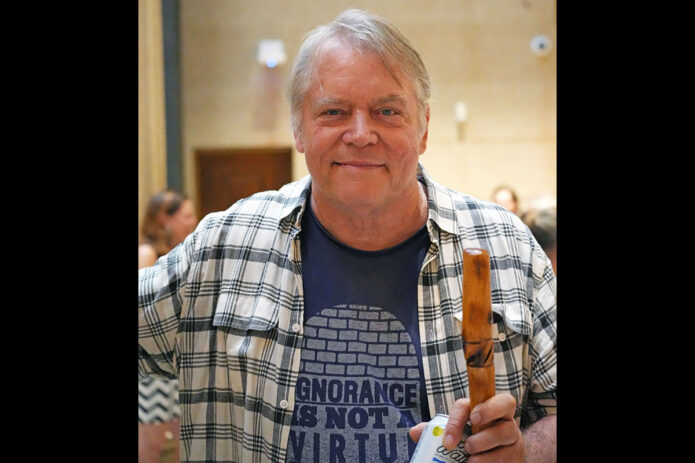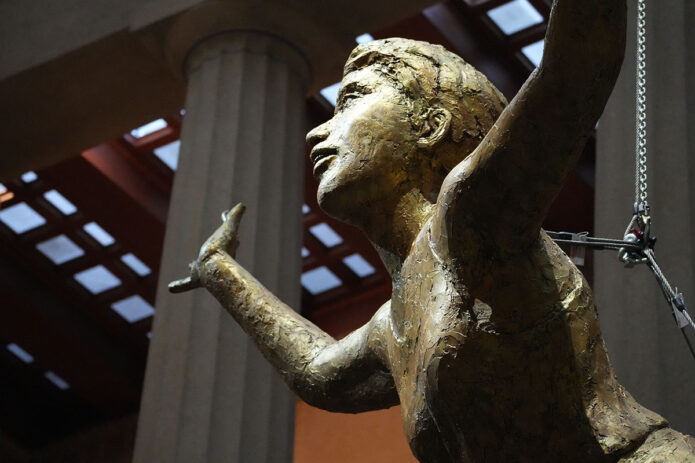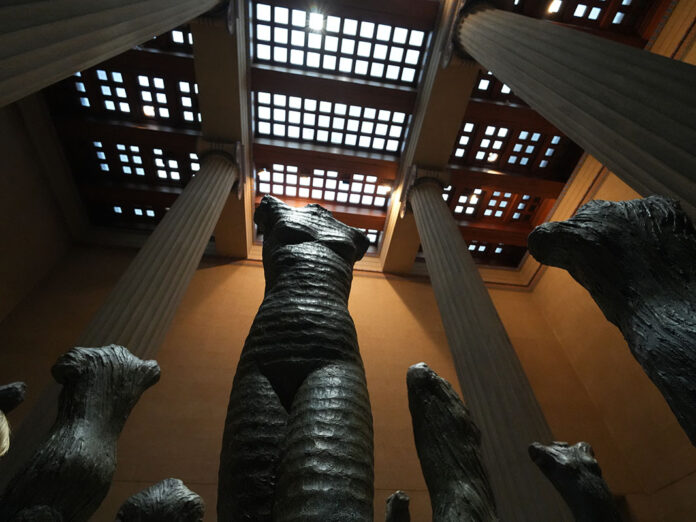Written by D.C. Thomas
 Clarksville, TN – Athena Parthenos, Musica, Dream Forest, and The Tennessee Woman Suffrage Monument are a few of the colossal sculptures through which Nashville-based sculptor Alan LeQuire brought forth his vision and mastery over the decades.
Clarksville, TN – Athena Parthenos, Musica, Dream Forest, and The Tennessee Woman Suffrage Monument are a few of the colossal sculptures through which Nashville-based sculptor Alan LeQuire brought forth his vision and mastery over the decades.
The words of Alan LeQuire echo into the art world, as he has become a monumental figure to many.
On the evening of June 12th, 2025, the Nashville Parthenon, located in Centennial Park, held the opening for Monumental Figures. This is the Parthenon’s first-ever solo exhibition, and it honors LeQuire’s life work and his recently completed works, highlighting figures such as Fannie Lou Hamer, soaring Olympians (Wilma Rudolph, Katie Ledecky, etc.), Odetta, Diane Nash, Dr. Dorothy Brown, Dr. Mildred Stahlman, and more.
Crowds gathered beneath the iconic columns for an evening of art, conversation, and reverence. The sold-out artist talk, held on June 24th, was another effect of LeQuire’s enduring influence on the local communities and their profound admiration for his legacy. LeQuire’s reach has extended across Tennessee.
In 2019, his clay models, wax castings, bronze sculptures, photographs, and more were featured in From Clay to Bronze at the Customs House Museum & Cultural Center in Clarksville, further affirming his position as a pivotal figure in Southern art.

In 2024, the Museum showcased his works again alongside art by Juliette Aristides, praised as “a living master”, in Juliette Aristides & Alan LeQuire: The Figure in Charcoal & Terra Cotta.
LeQuire’s journey began in the leafy hills of rural Tennessee. “I grew up on a farm, and there were lots of materials around me, including clay, wood, and stone. My mother was a painter, but she had made sculpture in college, and the tools for carving were there in her studio. I naturally wanted to carve as soon as I was old enough,” he said.
One can imagine how this early access to materials and artistic encouragement at home shaped his creative instincts. His father, a professor of anatomy, brought an academic layer to this environment, fueling his interest in the structure of the human body.
“My teachers sculpted the human figure, my father taught anatomy… My desire to know more about the human figure led me to try to understand academic training,” he continued.

In the 1960s, LeQuire was aware of the nation’s civil rights struggle. “I felt connected… and a strong sense of moral outrage at the way our government handled it.” Although not overtly political in his practice, he often channels his esteem for those who stood for justice. “We watched the protests every night on television. … I enjoy being able to express my love and admiration for those who fought for our rights,” he added.
The agrarian rhythm of his upbringing and a reverence for classical art encountered during his time in Europe left a lasting imprint. “In Europe, I felt this even more strongly in the art of Italy and France… it made me feel connected to those artists responding to that tradition,” he stated.His work is timeless, and the pastoral world remains a recurring theme, bridging the ancient and Southern landscapes. When asked about his sculptural process, LeQuire said, “I usually begin by drawing. Ideas seem to flow best out of my pen when I stop thinking.”
![Alan LeQuire's Odetta [Holmes]. (D.C. Thomas, Clarksville Living Magazine)](https://www.clarksvilleonline.com/wp-content/uploads/2025/07/Alan-LeQuires-Odetta-Holmes.-D.C.-Thomas-Clarksville-Living-Magazine-695x463.jpg)
Though he journals intermittently, drawing remains his primary method of ideation. “Drawing really is where most ideas happen and are improved.”
The towering Athena Parthenos, a defining project, is his most renowned work, “Athena Parthenos was the completion of my training as a sculptor” he said. “I was somewhat intimidated by the scale, but I knew I could figure out how to do it, and I had several people… ready to help me,” he remembers.
He worked closely with archaeologists to ensure historical integrity, blending research and vision to recreate a mythical symbol with enduring relevance. LeQuire resists the pressure to create exact replicas in portraiture.

“People expect complete realism… but I was never interested in realism. Most of my portraits are therefore a compromise between real and imagined elements.”
He seeks to balance accuracy with an expressive inner truth, profoundly evident in his public works. Among these stands the Wilma Rudolph sculpture, a tribute to the Olympic champion who overcame pneumonia, scarlet fever, polio, and racial barriers to become one of America’s greatest athletes.
Wilma’s rendition embodies the intersection of public memory, cultural history, and respect. This monumental figure seizes the athlete’s poise and her perseverance.
“Public art is important because… in the best cases it describes a community’s values,” LeQuire states.
In his view, much of today’s public art lacks specificity and emotional connection. His works, by contrast, elevate local stories, icons which were sculpted with the gravity of saints and warriors.

LeQuire honors their humanity through grand form and sculptural dignity. “I encourage my students to make as much by hand as they can,” he shares. In this world, increasingly dominated by digital tools, LeQuire remains steadfast in the tactile.
“The appreciation of three-dimensional form is something you learn in your body as well as your mind.”
As technology evolves, so does the scale of public art. “There will be more monumental sculpture going forward… but the works are not always very good.”
While acknowledging digital advantages, LeQuire advocates for a return to the authentic and the handmade, a hope perhaps embodied by the Monumental Figures exhibit itself. “For me, the process is by hand. If you take that away, there is no point,” he articulated.Alan LeQuire’s sculptures echo memory, tradition, and shared ideals. At the Nashville Parthenon, his figures are not relics but living symbols of who we are and what we value.
Monumental Figures invites viewers to look at the past, themselves, and what might be possible when art and identity stand side by side.
To discover more about Alan LeQuire and his career, visit The LeQuire Gallery in Nashville. More information can be found at www.lequiregallery.com



